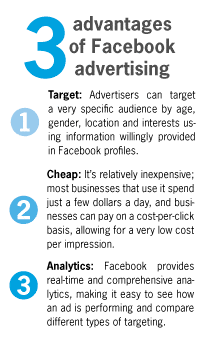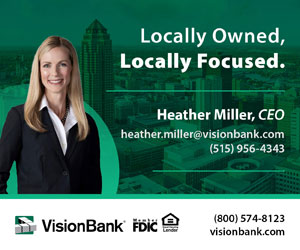On target
Area businesses can, should and do aim for specific audiences by advertising on social media platform Facebook


The restaurant’s owner, Anthony Lemmo, last year wanted to get more private parties in the form of rehearsal dinners for weddings. So he had his social media strategist, Phil James, owner of digital media consulting company Good Milkshake LLC, create specifically targeted advertisements on Facebook.
James created ads that would show up on the Facebook page of anyone who was listed as engaged or in a relationship, was older than 21 and lived in the Des Moines area. He mixed and matched photographs and looked at the analytics to find that women were more likely to click on the ads. The results: For just a few dollars a day, Cafe di Scala attracted customers for a handful of private parties.
“It’s not out of line to say (Cafe di Scala) probably got an 800 percent rate of return on Facebook ads – just because we were able to do it in such a way that was targeted specifically,” James said.
Facebook’s U.S. advertising revenues are expected to total about $2.2 billion this year, overtaking Yahoo Inc. for the highest share of online display advertising revenues, according to a report last month from research firm eMarketer Inc. Advertising and marketing agencies in Des Moines say businesses are finding that Facebook advertising is a way to complement their overall ad campaigns and target a specific audience for a small amount of money.
“It’s not the end-all, be-all,” said Aaron Kennedy, executive vice president at Flynn Wright. “Is it a fatal flaw in someone’s marketing mix or their plan of how they push their advertising? Probably not. But are they maximizing their opportunity? I would say no, they are not.”
For the most part, Facebook ads are not going to take the place of traditional advertising, he said. But they can be used effectively. One of Flynn Wright’s clients, Josephs Jewelers, has used an ad two years in a row for its Diamond Dash, a scavenger hunt in which couples try to follow clues to win a grand prize diamond ring.
For about $1,700, Josephs was able to generate more than 4.6 million impressions, or views, to a specialized audience of participants above the age of 21. Josephs also marketed the event through its Facebook fan page and with some radio spots, but Josephs Vice President John Joseph credits the Facebook ad in large part for getting 2,500 applicants.
Drew McLellan at McLellan Marketing Group said his clients have had a lot of success with Facebook ads. It works especially well with the 20- to early-30-year-old age group, he said.
It’s not just for younger demographics, though.
“We have had great success with every Facebook ad campaign that we’ve run, and we’ve run them for a variety of clients for a variety of audiences,” McLellan said. “What is great about the Facebook ads is how absolutely micro-targetable they are. So if you want to talk to people within a very tight age range or a very tight geography, or people with a very defined interest or education level, all of that is easy to do.”
The platform works best for business-to-consumer advertising, McLellan said, something reiterated by others. Kennedy at Flynn Wright and Josh Fleming at Lessing-Flynn Advertising said they have seen the most use come from retailers selling consumer products, goods and services.
In addition to having a specific target audience, it helps for businesses to be targeting a specific event or product, something that is hard for the target audience to ignore.
A major disadvantage to advertising on Facebook is a general lack of creativity, meaning that audiences tend to be less engaged when viewing Facebook ads than when they’re watching a television commercial or seeing ads while flipping through a newspaper or magazine.
That’s why it’s important to keep close track of how the ads are performing. To assist businesses in that task, Facebook provides real-time analytics.
“I think that there’s a real challenge with marketers and individual business owners not testing ads enough,” said Fleming, whose firm has consulted with somewhere between 30 and 40 businesses on the use of Facebook ads. “They just run one ad, and then they’re done. They have the ability to run tens of ads if they want to and see which ones work the best.”
It also works well in tandem with a Facebook fan page, which is free to set up. Some businesses will use advertising to direct people to the fan page for a special deal or event. Others will direct users to their website. Katie Miller-Smith, director of Catchfire Media LLC, warns that the link must be relevant to the ad and keep the reader engaged after clicking.
What also makes Facebook relevant to advertisers is the high amount of traffic that comes to the site, and the amount of time people spend on the site, she said. That’s what has made the platform more attractive than other social media sites or websites such as Yahoo and Google Inc.
“It comes down to the idea that this is where people are spending their time,” Miller-Smith said. “Why wouldn’t you want to be there?”











